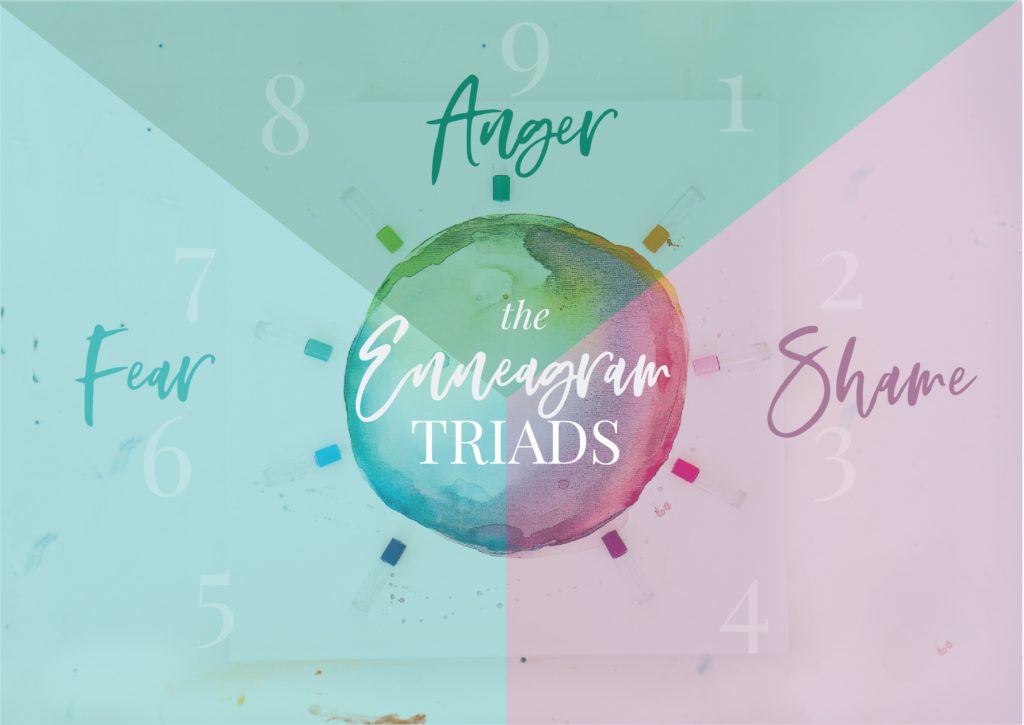
*I am an Enneagram enthusiast. It has impacted my life in profound ways, and I hope you will benefit from its teaching as well. Please always refer to the experts (an Enneagram teacher, certified coach, or counselor) — they know best! Also, check out The Enneagram Institute for a great online resource about the Triads. You can also read my posts here and here if you’re new to The Enneagram.*
I love the complexity that The Enneagram offers in explaining who we are. After all, it’s logical that our human-ness can’t be explained away in a nice, neat list. We are messy and seemingly inconsistent, so making sense of how and who we are is complex, too!
One of the most fascinating aspects of The Enneagram is how the numbers all relate to one another in Wings and Arrows — and Triads. Some people also refer to these as “Centers.”
The Enneagram’s nine types can be broken down into three groups. The three Triads are referred to as Gut/Instinct, Heart/Emotion, and Head/Reason. Although many teachers use these names to refer to the Triads, I like to talk about them in terms of their Dominant Emotion because I find that the Dominant Emotion is what people most easily relate to.
So what is a Dominant Emotion? Simply put, each group of numbers has a major struggle with a particular emotion: Anger, Shame or Fear. Of course everyone experiences all three of these emotions, but people have a very intense relationship with the Dominant Emotion of their Triad. The main, overarching struggle woven throughout most of the issues a person has can usually be distilled down to that Triad’s Dominant Emotion.
Each number has it’s own unique way of dealing with this integral emotion:
The Anger Triad (8-9-1)
8s openly express their Anger — raising their voices, getting worked up or becoming physical.
9s deny that they are angry and push it down for as long as possible.
1s internalize their Anger in an attempt to remain in control.
The Shame Triad (2-3-4)
Pretty much all three numbers in The Shame Triad try to create feelings of worthiness to rid themselves of their deep-seeded Shame:
2s make themselves feel valuable by helping others.
3s compensate with success, attention and accolades.
4s focus on their unique qualities.
The Fear Triad (5-6-7)
5s fear of the world around themselves (misunderstanding it or being intruded upon by it), so tend to become isolated.
6s fear unpredictability and are thus always on guard and seeking security.
7s fear their inner emotions and try to ignore them through external excitement.
In reality, people deal with their Dominant Emotion in very complex ways. So because the synopses above are simple, view them as starting point to process your Dominant Emotion.
You’ll notice that 3, 6 and 9 are in the centers of each Triad. These numbers are thought to identify with the Triad’s Dominant Emotion the most deeply — but can also be the most out of touch/in denial about that emotion. (Experiencing a negative emotion intensely can result in denial as a function of self-preservation.) To make sense of this, remember that the wings for each of those numbers, no matter with side they lean to, are also within that Triad. For example, a 2w1 mainly struggles with Shame, but also leans into the Anger Triad in their second personality layer (Wing). But a Three only leans into the Shame of a Two or a Four — double Shame. (Lucky us, Threes!)
If you’re still struggling to figure out if your number is accurate, try to have an honest conversation with yourself about your Triad’s Dominant Emotion. For me, as a Three, applying the word “Shame” or “Guilt” to many of my internal struggles made a lightbulb go off in my head. Does “Fear” or “Anxiety” or “Stress” explain your motivations? Does “Anger” or “Frustration” impact your actions? Once again, we all experience every one of these emotions, but your Triad’s emotion will be an overarching issue for you.
Next time we’ll talk about Habits & Challenges for each number and how essential oils can help you along your Enneagram journey!
